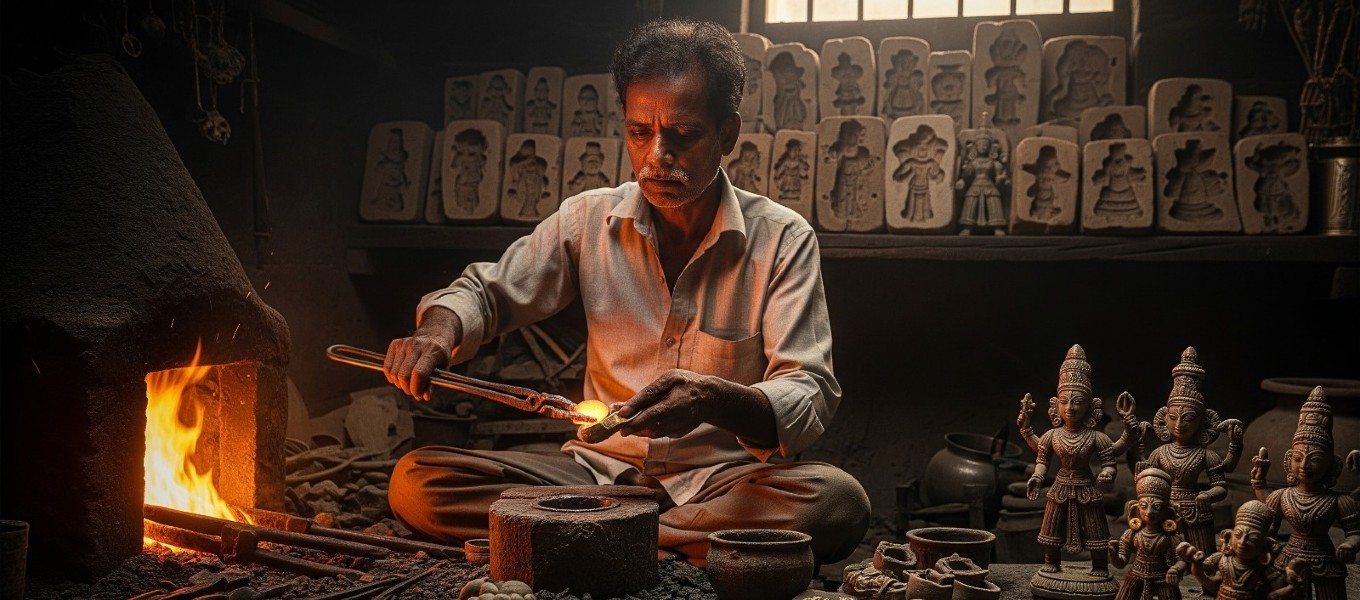Don't miss this exciting offer — contact us today and make it yours!

In a world dominated by mass production, Dhokra art stands as a radiant example of handcrafted brilliance. Practiced for over 4,000 years, this ancient lost-wax metal casting tradition from Bengal’s tribal communities isn’t just art — it’s living heritage. With intricate designs and eco-friendly methods, Dhokra has journeyed from tribal villages to museum showcases, fashion homes, and international collectors.
This case study explores how Dhokra art from Bengal, particularly the artisans of Bikna village (Bankura) and Dariyapur (Burdwan), is preserving culture while driving livelihood, tourism, and global interest in sustainable indigenous art.
Dhokra (also spelled Dokra) is a form of non-ferrous metal casting using the lost-wax technique — one of the oldest known methods of metal casting. Traditionally practiced by the Dhokra Damar tribes, the art uses brass, beeswax, clay, and firewood to create everything from figurines and jewelry to deities and decorative pieces.
Each Dhokra piece is one-of-a-kind — no two items are ever alike.
Dhokra isn’t just decorative — it’s spiritual and symbolic. Common motifs include:
Tribal deities and gods
Elephants, horses, and owls symbolizing strength and prosperity
Folk musicians and village scenes portraying everyday tribal life
Nature-based themes like trees, vines, and rivers
The process itself takes 15–30 days per item, combining patience, generational skill, and storytelling — making each Dhokra piece a cultural artefact.
Despite its artistic and cultural value, Dhokra artisans face challenges:
Limited market access and visibility
Middlemen taking major profits
Lack of digital literacy among artisans
Modern buyers unaware of its value or origin
Rising raw material costs and shrinking traditional patronage
There was a dire need to modernize the ecosystem without losing authenticity.
Organizations like DC Handicrafts, NIFT, and independent design studios began introducing contemporary design elements — blending utility with tradition (e.g., Dhokra lamps, coasters, and jewelry).
Platforms like Amazon Karigar, Okhai, and Gaatha enabled Dhokra artisans to sell globally. From New York lofts to Tokyo boutiques, Dhokra began appearing as a symbol of sustainable luxe.
Geographical Indication (GI) tag granted to Dhokra of Bengal.
Training camps and artisan clusters helped improve skill, quality, and pricing strategy.
Handicraft melas, expos, and cultural festivals boosted direct-to-customer sales.
Filmmakers, bloggers, and creators began spotlighting the artisans’ journeys. Instagram reels, documentaries, and YouTube vlogs captured the rustic process and raw emotion — building global interest in ethical, handmade luxury.
Over 3,000 artisans in Bengal directly benefit from Dhokra.
Household income rose by 30–50% in organized clusters like Bikna and Dariyapur.
Women artisans became financially independent by learning casting, polishing, and finishing.
Dhokra products began featuring in luxury décor stores, corporate gifting, and even fashion jewelry lines.
Crafts Council of India curated Dhokra-themed exhibits in Europe and Singapore.
Fashion designers used Dhokra buttons, pendants, and embellishments on haute couture.
UNESCO, FabIndia, and Tata Trusts have highlighted Dhokra artisans in cultural documentation projects.
Even brands like Forest Essentials and Good Earth have used Dhokra elements in store interiors and packaging stories.
Eco-friendly & Sustainable – No industrial machinery or synthetic materials.
Culturally Rooted, Globally Loved – Combines rural authenticity with urban aesthetic.
Slow-Made & One-of-a-Kind – Each piece is a conversation starter.
Supports Tribal Livelihood – Conscious consumers prefer items that give back.
Craft is Content: The process of Dhokra casting is visually rich — perfect for reels, behind-the-scenes, and storytelling campaigns.
Tradition Is a Trend: Customers seek deeper meaning in purchases. Dhokra’s history adds value.
Cultural Commerce Works: Merging tribal artistry with design and tech creates a new economic narrative.
Dhokra art of Bengal is not just a metal craft — it’s a metaphor for India’s living, breathing heritage. It shows how, with the right storytelling, support, and market access, even the oldest traditions can shine brightly in the modern world.
In the hands of tribal artists, metal becomes magic — and in the hands of mindful marketers, that magic becomes a movement.